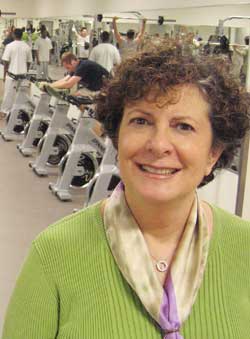Education researcher helps youth face hype

Lois Baron (Education) wants her forthcoming book on youth and sport to be relevant for coaches, parents and teachers as well as students.
marion elissalde
Parents exhibiting hockey rage and sexual harassment by coaches make headlines, but education professor Lois Baron calls these “the aberrations that sell newspapers.”
“I was interested in physical education, active living and well-being, and children.”
When she tried to find a textbook to deal with these issues, she couldn’t. So she decided to write one. Contemporary Issues in Youth Sport is due out later this term.
“I wanted to write something that would be useful not only for my students, but also for parents, teachers and coaches.”
That practical intention led Baron to review the literature dealing with preschoolers up to about university age. She found biases in media coverage and some gaps in the research itself.
“You hear plenty about parents who hit coaches, but not about the parents who drive their children to swimming or hockey practice at 5 a.m.” That kind of information made it into the section on parental involvement. So did larger questions of fair play in another section of the book.
“The motivational climate is really important. Is it an ego-oriented environment, or a task-oriented one?” That philosophy can change either from coach to coach or at different stages in the same child’s life. She was surprised to learn that elementary-school-age children (“the group I’m most interested in”) were the least represented in the literature.
In the wake of the Super Bowl, the connection between children, sports and commercialism is another timely chapter in the book. Advertisers pay millions of dollars for key spots during the game telecast, and the hype around these spots gets almost as much attention as the game itself.
Baron said that although the U.S. telecast ads are not aired in Canada, where local ads are substituted, the hype has still trickled north of the border.
Of course, paid commercials are only the tip of iceberg. Sponsors can purchase space on the ice or floor of stadiums (even in high schools), on the boards around rinks and on screens projected to fans and the television audience. Athletes and teams themselves are heavily sponsored.
“It’s been said that Olympic athletes represent companies more than their own countries,” Baron said. “We’re surrounded by that kind of marketing. The minute a skier finishes a race, she grabs a ski and holds it up to the camera.”
Just last month, the Concordia Stingers men’s hockey team made the front page of The Gazette in a lengthy article about Reebok-CCM’s sponsorship of the team’s equipment. The team benefits from an unlimited supply of skates, clothing and sticks in exchange for feedback on the new products. The deal was presented both as an economic boom for the team (money saved by not purchasing this material has been put to other use) and as an enthusiastic promotion of the equipment itself.
In earlier research, one of Baron’s goals was to give children the tools to develop a more critical awareness of TV, advertising and their position as a market. In a similar vein, her chapter on abuse in youth sport stresses the need to help children identify abuse, instead of professionals addressing the problem once it has occurred.
Baron knows that without government funds, a general commitment to positive physical activity experiences for all children and a focus on the potential of sports involvement as life skills development, very little is going to change.
“My goal in writing the book is to educate people about these issues. How can we make the sporting environment more healthy and secure?” She is encouraged by the Ministry of Education’s recent exploration of yoga, martial arts and other types of physical activity that stress confidence and fun over competition.